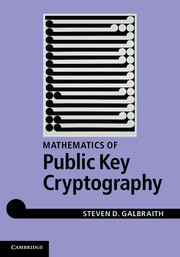Book contents
- Frontmatter
- Contents
- Preface
- Acknowledgements
- 1 Introduction
- PART I BACKGROUND
- PART II ALGEBRAIC GROUPS
- PART III EXPONENTIATION, FACTORING AND DISCRETE LOGARITHMS
- PART IV LATTICES
- PART V CRYPTOGRAPHY RELATED TO DISCRETE LOGARITHMS
- PART VI CRYPTOGRAPHY RELATED TO INTEGER FACTORISATION
- PART VII ADVANCED TOPICS IN ELLIPTIC AND HYPERELLIPTIC CURVES
- 25 Isogenies of elliptic curves
- 26 Pairings on elliptic curves
- Appendix A Background mathematics
- References
- Author index
- Subject index
25 - Isogenies of elliptic curves
from PART VII - ADVANCED TOPICS IN ELLIPTIC AND HYPERELLIPTIC CURVES
Published online by Cambridge University Press: 05 June 2012
- Frontmatter
- Contents
- Preface
- Acknowledgements
- 1 Introduction
- PART I BACKGROUND
- PART II ALGEBRAIC GROUPS
- PART III EXPONENTIATION, FACTORING AND DISCRETE LOGARITHMS
- PART IV LATTICES
- PART V CRYPTOGRAPHY RELATED TO DISCRETE LOGARITHMS
- PART VI CRYPTOGRAPHY RELATED TO INTEGER FACTORISATION
- PART VII ADVANCED TOPICS IN ELLIPTIC AND HYPERELLIPTIC CURVES
- 25 Isogenies of elliptic curves
- 26 Pairings on elliptic curves
- Appendix A Background mathematics
- References
- Author index
- Subject index
Summary
Isogenies are a fundamental object of study in the theory of elliptic curves. The definition and basic properties were given in Sections 9.6 and 9.7. In particular, they are group homomorphisms.
Isogenies are used in algorithms for point counting on elliptic curves and for computing class polynomials for the complex multiplication (CM) method. They have applications to cryptanalysis of elliptic curve cryptosystems. They also have constructive applications: prevention of certain side-channel attacks; computing distortion maps for pairing-based cryptography; designing cryptographic hash functions; relating the discrete logarithm problem on elliptic curves with the same number of points. We do not have space to discuss all these applications.
The purpose of this chapter is to present algorithms to compute isogenies from an elliptic curve. The most important result is Vélu's formulae, which compute an isogeny given an elliptic curve and a kernel subgroup G. We also sketch the various ways to find an isogeny given an elliptic curve and the j-invariant of an elliptic curve ℓ-isogenous to E. Once these algorithms are in place we briefly sketch Kohel's results, the isogeny graph and some applications of isogenies. Due to lack of space we are unable to give proofs of most results.
Algorithms for computing isogenies on Jacobians of curves of genus 2 or more are much more complicated than in the elliptic case. Hence, we do not discuss them in this book.
- Type
- Chapter
- Information
- Mathematics of Public Key Cryptography , pp. 515 - 544Publisher: Cambridge University PressPrint publication year: 2012



